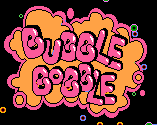Bubble bobble
| Bubble bobble | |
|---|---|
| Studio | Taito |
| Publisher | Taito |
| Senior Developer | Fukio Mitsuji |
| Erstveröffent- lichung |
1986 |
| genre | platform |
| Game mode | Up to 2 players at the same time |
| control | Joystick (2-way); 2 buttons |
| casing | default |
| Arcade system | Main CPU : 2 × Z80 6MHz Sound CPU: Z80 3MHz |
| monitor | Raster , resolution 256 × 224 (horizontal) Color palette: 256 |
Bubble Bobble is a Jump 'n' Run game for one or two players. The first version was released by Taito in 1986 . Further parts and portings to different platforms appeared later.
action
The friends of the brothers Bubby and Bobby were kidnapped by Baron Von Blubba. The baron has also transformed the brothers into the two bubble kites, Bub and Bob. The two have to survive 99 levels in the cave of the monsters in order to meet Baron Von Blubba personally on the 100th level. If you defeat him, your friends will be saved.
Game principle and technology
The levels each consist of a static screen with platforms arranged next to and one above the other. The player can run with his pawn to the left and right and jump a little; he can jump to an adjacent platform or a platform slightly above him. If he drops from a platform, he lands on the next platform below him. Each level contains a predefined number of opponents that the player must defeat. The character must spit bubbles and use them to envelop their opponents. The bubbles with the enveloped opponents are to be made to burst by jumping on them. As a result, symbols (banana, cherry, cake, biscuits, ...) are displayed for a short time, which bring different numbers of points. Some items have special functions. An umbrella skips several levels, electric lightning can be fired, a ball lightning kills all opponents, or Bub and Bob can briefly spit fire.
Bubble Bobble was one of the first games with a cooperative two-player mode and the first with such a large pool of items. Some of the items are triggered by internal counters, others only appear in the highscore list after a certain number of certain character strings.
Production notes
Bubble Bobble is available for Amiga , Apple II , Atari ST , C64 , Game Boy , Game Boy Advance , Game Gear , MS-DOS , MSX2 , NES , PlayStation , Schneider CPC , Sega Master System , Sega Mega Drive , Saturn , TI- 84 Plus , WiiWare , Xbox Live Arcade and ZX Spectrum .
The follow-up games were Rainbow Islands - The Story of Bubble Bobble 2 (1987), Bubble Bobble II (1994) and Bubble Memories - The Story of Bubble Bobble III (1996). In 1991 Parasol Stars - The Story of Bubble Bobble III was released for the Japanese PC engine console and the Commodore Amiga. Despite having the same subtitle as Bubble Memories, it had no resemblance to the original and was a completely separate game.
The awareness of the Bubble Bobble brand led to a merchandising business. Even 30 years after the machine appeared, Bub and Bob plush dolls were still being sold.
reception
| ||||||
The zzap! 64 magazine described the C64 port as "one of the best if not the best platform game of all time" and "extremely addictive". It turned out that the C64 implementation came closer to the original in terms of graphics, music and gameplay than any other arcade port. The magazine 64'er recorded Bubble Bobble in his retrospective Games '88 "Best implementation" of.
Web links
- Bubble Bobble in the Killer List of Videogames (English)
- Bubble Bobble at MobyGames (English)
- Bubble Bobble level guide on adamdawes.com (English)
Individual evidence
- ↑ Adam Dawkes: Bubble Trouble ( English ) In: Retro Gamer magazine . adamdawes.com. 2004. Retrieved January 11, 2013.
- ↑ Youtube.com: Bubble Bobble Plush With Sound Effects! Retrieved March 3, 2017 .
- ↑ a b Zzap! 64 # 30, October 1987, p. 12: Bubble Bobble. Retrieved February 1, 2017 .
- ↑ 64'er 2/1989, p. 16


